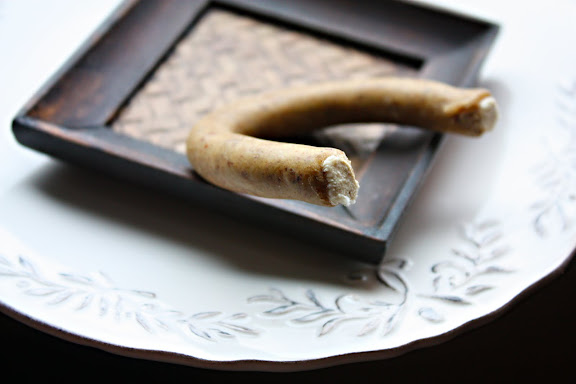
There’s something melancholic — almost mournful — about the scent of this traditional Thai dessert candle which I can’t identify. That’s a bit ironic considering how the candle is used exclusively to perfume food, primarily sweets and dessert ingredients. Could the culprit be its main ingredient, frankincense, used in many parts of the world in burial rituals? Could it be that just one whiff of it and I’m transported to the home I grew up in — the one that was recently demolished? Or could it have something to do with the fact that this is a candle whose sole purpose in life is to be burned ever so briefly then snuffed out? I don’t really know. Continue Reading →
Archive | She Thais RSS feed for this section
Thai Scented Candle (Tian Op เทียนอบ) and How to Use It to Perfume Food
Thai Garlic-Peppercorn-Cilantro Root Aromatic Paste

On the (by no means exhaustive) list of composite ingredients commonly used in Thai cooking which I’ve mentioned in this CNN article is this basic aromatic paste comprising fresh garlic, white peppercorns, and cilantro roots that is used in various dishes, most notably as part of a marinade. This represents one of the basic things that, once incorporated into your repertoire, will make Thai cooking much easier and more intuitive to you.
Is this all the Thai people use to marinate things? No. Is this the sacred marinade without which all Thai meat dishes are declared unrighteous? Of course not. I don’t think there ever was a council of Thai culinary gurus who got together at one point in our history and came up with a “we believe” document in the manner of Nicaea. But if you look closely at the various marinades used in traditional Thai dishes, you’ll see that these three ingredients represent what most, if not all, of these marinades have in common. Continue Reading →
Baby Bananas in Heavy Syrup (Kluay Khai Chueam กล้วยไข่เชื่อม)

This classic Thai dessert is great warm, at room temperature, cold, or topped with crushed ice. It’s also pretty easy to make. You need baby or nino bananas, though; regular cavendish bananas turn all mushy and weird in the simmering syrup.1 And don’t skip the coconut cream topping; it is the vehicle for the saltiness that this sweet dessert desperately needs.
Baby Bananas in Heavy Syrup (Kluay Khai Chueam กล้วยไข่เชื่อม)
Printable Version
10 under-ripe baby bananas2, peeled and soaked in salted water for 5 minutes3
1.5 cup water
1.5 cup granulated sugar
1 cup coconut milk
3 tablespoons rice flour or 2 tablespoon all-purpose flour
1 teaspoon salt
1 This is why traditionally only nino bananas (Kluay Khai) and burro bananas (Kluay Nam Wa) and never cavendish bananas (Kluay Hom) are used to make this dessert. Having said that, I’ve used cavendish before solely out of necessity and, though it didn’t yield optimal result, it wasn’t abominable. If you really can’t find nino or burro, which can be hard to find, feel free to use cavendish. Pick ones that aren’t so ripe; otherwise, they fall apart on you after cooking.
2 They should be about 50% yellow and 50% green.
3 Do not skip this step. The salted water will help remove much of the sticky substance on bananas that are under-ripe. Failure to do this will result in unsightly brown spots on the cooked bananas. A tablespoon of salt for every quart (32 fluid ounces) of water should do.
Enter your email to subscribe:
ARCHIVES
-
 Subscribe to The Epestle to Receive New Posts
June 30, 2021
Subscribe to The Epestle to Receive New Posts
June 30, 2021
-
 Introducing THE EPESTLE
February 13, 2021
Introducing THE EPESTLE
February 13, 2021
-
 Bury Me in Nam Phrik: Mike Sula’s Exploration of Thai Relishes (Plus Salted Soybean-Pork Rind Relish Recipe)
May 1, 2018
Bury Me in Nam Phrik: Mike Sula’s Exploration of Thai Relishes (Plus Salted Soybean-Pork Rind Relish Recipe)
May 1, 2018
-
 Food and Cooking in Thai TV Dramas, Love Destiny, 17th Century Siam, and Crispy Noodle-Wrapped Pork Dumplings
April 2, 2018
Food and Cooking in Thai TV Dramas, Love Destiny, 17th Century Siam, and Crispy Noodle-Wrapped Pork Dumplings
April 2, 2018
-
 A Simple Thai Dipping Sauce
March 12, 2018
A Simple Thai Dipping Sauce
March 12, 2018
-
 Northern Thai Rice Noodle Soup with Pork Ribs, Dried Cotton Flowers, and Tomatoes (Khanom Jin Nam Ngiao)
September 1, 2017
Northern Thai Rice Noodle Soup with Pork Ribs, Dried Cotton Flowers, and Tomatoes (Khanom Jin Nam Ngiao)
September 1, 2017
-
 How to Prepare Rice Vermicelli (Khanom Jin) from Dried Noodles
August 29, 2017
How to Prepare Rice Vermicelli (Khanom Jin) from Dried Noodles
August 29, 2017
-
 How to Prepare Pomelos for Thai Pomelo Salad
May 23, 2017
How to Prepare Pomelos for Thai Pomelo Salad
May 23, 2017










